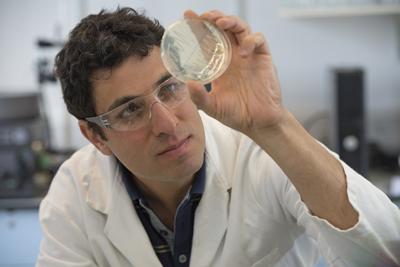New study yields more than a million new cyclic compounds, some with pharmaceutical potential

Researchers say they can now produce a vast library of unique cyclic compounds, some with the capacity to interrupt specific protein to protein interactions that play a role in disease. The new compounds have unique cyclic structures that give them stability and enhance their ability to bind to their targets.
The study, reported in the journal Nature Chemical Biology, also revealed that one of the newly generated compounds interferes with the binding of an HIV protein to a human protein, an interaction vital to the virus’s life cycle.
The report was co-authored by Professor Ali Tavassoli from the University of Southampton and Professor Wilfred van der Donk from the University of Illinois and the Howard Hughes Medical Institute.
Professor Wilfred van der Donk said: “Most drug-discovery efforts focus on disease-inducing interactions in enzymes and proteins that involve classic “lock-and-key” mechanisms.
“In most cases, small chemical drugs bind to cavities in enzymes, where the chemical reactions take place. By binding to these crevices, the drugs prevent the enzymes from working. However, many disease processes involve protein-protein interactions that do not fit this model.
“These have long been considered challenging because they do not involve such cavities. These protein-protein interactions often are made up of extended surfaces that can be difficult to inhibit with small molecules.”
Professor Ali Tavassoli added: “While significant strides have been made against a variety of protein-protein interactions, including our own work with cyclic peptide libraries, there is much potential for using new chemical scaffolds for this purpose.”
While linear proteins are problematic, cyclic molecules composed of one or more rings of amino acids are more stable and less susceptible to cellular enzymes that tend to chew off the ends of linear proteins. They are thus more likely to successfully bind to their targets.
In the new study, researchers made use of an enzyme they discovered from a bacterium that lives in the ocean and tested whether it could make analogs of these natural products in Escherichia coli.
The team found three potential therapeutic agents. Further testing revealed that one of the three worked best. In a test tube and in cells, the compound bound to the human protein, stopping the HIV protein from interacting with it.
This drug agent likely will not be used therapeutically, however, as it may have toxic side effects at high doses as a result of its interaction with the human protein, the researchers said.
“We engineered the genes of the E. coli strain such that its survival depended on disrupting the interaction between the human protein and an HIV protein,” Professor Tavassoli said.
“The real advance here is the ability to generate libraries of millions of potentially therapeutic agents,” Tavassoli said. “These could be screened to identify inhibitors of other disease-related processes, which is where its real potential lies."
